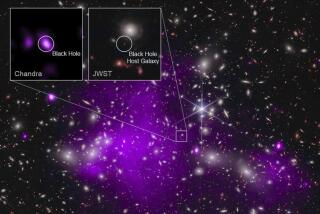Doesn’t Fit Any Conventional Theory : Massive Object Discovered in Space
- Share via
NEW YORK — Astronomers have found evidence of what could be the most massive object in the universe, 1,000 to 10,000 times the mass of the Milky Way and an estimated 5 billion light years away, one of the researchers said today.
Edwin L. Turner, professor of astrophysics at Princeton University, said he discovered the mass in March while studying a quasar behind it.
“We thought for years we had two separate quasars,” he said. “Then we compared thumbprints, so to speak, and realized it was one quasar with something in front of it splitting the light we perceived into two.”
The object, which from Earth would appear to be in the constellation Leo, probably lies about halfway between Earth and an apparent pair of starlike quasars several more billion light years away, Turner said.
He estimated that the mass is 1.5 million light years across and about 5 billion light years from Earth. A light year is the distance it takes light to travel in one year, about 5.9 trillion miles. The distance between Earth and the sun, for example, is about eight light minutes.
The new object has about 1,000 times the gravitational density of a normal galaxy, Turner said, leading some astronomers to speculate that it is a cluster of galaxies, pressing together with tremendous gravitational force.
Differing Theories
Other astronomers contend that it is a black hole and still others believe that it may be a cosmic string--a phenomenon predicted by Albert Einstein in which gravity from early fragments of the universe create optical effects.
But Turner said the newly discovered mass does not quite fit any of these conventional theories. It is larger, more powerful and all but invisible to the powerful observational equipment astronomers rely on.
“The cluster galaxy is the most conventional theory,” he said. “But we have been able to observe cluster galaxies in the universe in ways we cannot observe this.”
The scientists have not seen the object directly, but can estimate its size and gravitational pull, Turner said.
Cosmic strings produce double images when light hitting loops of gravity are distorted, as if passing through a giant lens in space. The phenomenon was predicted by Einstein in the 1930s and first found in 1979, Turner said. Five cosmic strings have been identified since, but none of these so-called gravitational lenses has been as powerful as this one.
A black hole is created when matter collapses in on itself, creating a gravity force so strong light cannot escape.





